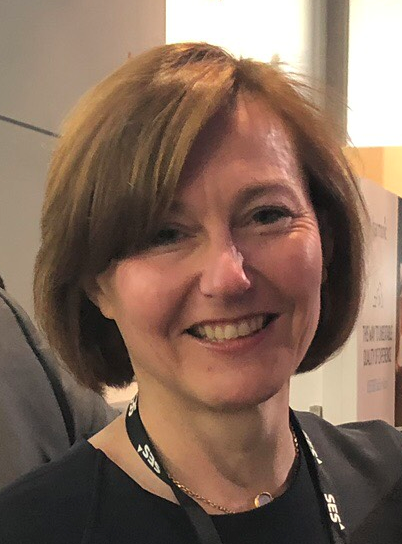NAB 2019 Reflections: SES’s Steve Corda and MX1’s Susanna Mandel-Mantello on the Growth of 4K, Power of Live Sports
SES and MX1 had a busy week in Vegas during NAB 2019, touting SES’s growing 4K Ultra HD platform, and a host of MX1 solutions, including the MX1 360 unified media platform, the new broadcast-scale Online Video Platform (OVP), the company’s OU Flex service, and an enhanced sports- and events-management tool paired with a new live-events booking platform.
SVG sat down with SES VP of Business Development Steve Corda and MX1 VP/Head of Sales, Sports, and Events Susanna Mandel-Mantello to discuss the growing market for 4K UHD, MX1’s offerings at the show, and more.
On the MX1 side of things, what were the primary announcements and demos at NAB 2019?
Mandel-Mantello: At the NAB Show, MX1 showed its MX1 360 unified media platform for managing and delivering linear and nonlinear content to any broadcast, VOD, or OTT platform. This powerful, next-generation platform enables broadcasters and service providers to offer a full range of end-to-end services, as well as successfully aggregate, manage, and deliver linear and nonlinear content. With MX1 360, one platform does it all, delivering a one-stop shop for broadcasters to handle all their content requirements — from preparing, packaging, managing, and validating high-quality content to reliable playout and optimal delivery for multiscreen viewing.
One of the enhancements demonstrated for MX1 360 at NAB was a new sports- and events-management interface for individual matches to team sports with any group of licensees from around the world, aimed at sports and event content owners and distributors. The new interface, managed through the MX1 360 unified media platform, allows sports and event organizations and rightsholders to easily manage and share broadcast-quality media containing matches, clips, and highlights, as well as related images, documents, metadata, and more.
Also on display was the company’s new live-events booking interface, which connects MX1’s sports and events customers with its 24/7 live-events booking team, simplifying the planning, monitoring, and coordination of live-event–content distribution. The booking interface features one-click sharing of live events with licensees from around the world, who receive real-time notifications and access to mission-critical distribution details. The integrated solution can be used for both single-live-event management and more-complex sports tournaments with multiple concurrent live events.
Can you provide an update on SES’s 4K Ultra HD platform and where you see the 4K UHD market headed this year?
Corda: We’re seeing a lot of progress in Ultra HD across North America. More 4K TVs are now being delivered than HD TVs, signaling [that] the penetration is growing significantly. If you assume one TV per household, 100 million paid-TV households, we’re at about the 50% level.
One of the major bottlenecks has always been set-top boxes, but we are now seeing a lot more [4K-capable] set-top boxes being deployed — hundreds of thousands in some of the larger, tier-one MVPDs.
And our growing, core set of 4K channels that we launched a few years ago is flourishing. We now have about 35 MVPDs on the SES Ultra HD platform. All of the tier-ones have been testing and trialing 4K with us, leveraging our lineup of nearly a dozen 4K channels. That represents the largest bouquet of 4K content in the world.
Consumer appetite for quality 4K is being satisfied by an increasing number of pay-TV providers, thanks to the availability of quality 4K content, 4K set-top boxes, and SES’s Ultra HD platform. The SES UHD solution combines great content, satellite distribution, and reception gear into an offering that is easily integrated into cable, IPTV, and DTH systems.
Our 4K channels offer up compelling content and have been very well received in TV markets across the U.S. and North America. A challenge of course is that we have yet to see the big brands come on board. The channels have content coming from the same studios as the brand names, but it’s all about brand recognition. The channels on the SES platform offer hundreds of hours of great content, including Travelxp and Insight TV — which were among the first 4K HDR channels to hit the market and arguably among the best channels on television today.
How much of a driver is live sports content in the growth of 4K UHD adoption?
Corda: In my view, the most compelling content [in 4K] has always been sports. We’ve carried lots of sports, including the Olympics for NBC, some sports with iNDEMAND, and most recently, last fall, college football and Major League Baseball postseason games with Fox Sports.
SES is keenly focused on sports, having stood up two events channels that are available 24/7 for anyone looking to distribute sports to the MVPDs and their affiliates. We’ve done some sports this year already and see ourselves delivering an extremely large number of sports events this year — probably 10 times what we enabled last year.
A broad range of sports distributors have seen the tremendous success we’re having in live 4K sports, and they’re ready to leverage our platform right now. These are the brand names as well as a few that are just starting out and getting the rights to some very interesting sports content. We’re carrying at least one sporting event a week currently, sometimes two or three events a week. We expect we’re going to probably be running full-time with a few of the major events this summer.
What are the most significant remaining challenges facing the 4K UHD live–sports-production ecosystem?
Corda: The biggest challenge is driving more full-time channels. The affiliates or the MVPDs currently have to stand up a separate channel for a particular sports event. Last fall, for example, Fox Sports had the HD game on FS1 and the 4K coverage was on a separate channel that cable operators had to point 4K customers to in order for them to see the game. I think that’s a challenge right now because it’s not a full-time channel and that forces cable operators to constantly market and inform the customers [where to find the single-event 4K channel].
We would like to get to the point where a Fox, ESPN, or whoever launches a full-time 4K channel. It would be a lot easier for them, a lot easier for us, a lot easier for the MVPDs and their subscribers, and it would also allow seamless integration of the interstitials and commercial insertion. Right now, we typically go to a wide-angle shot for the entire intermission of halftime. That’s not very compelling. We’re constantly in discussion with those cable networks to understand what their status is in terms of launching a full-time [4K] channel. I know a lot of them are looking at it, and it’s a very complex process because they need so much 4K content.
Do you see HDR as a must-have part of the 4K UHD equation moving forward?
Corda: I don’t see a 4K channel launching in anything but HDR. 4KUNIVERSE, a channel on our 4K platform, is the latest to convert to HDR, and I don’t see a new channel launching without it.
When it comes to sports, the higher frame rate with 60p is a huge factor. And whether it’s 1080p HDR or 4K HDR, they’re both great. I do think, though, as TV sizes continue to grow, if you’re going to HDR, you are going to need a path to 4K because it’s a very noticeable improvement.
Have you seen much interest in delivery of 8K content thus far?
Corda: We’ve been doing [8K] demos on satellite for some time, and we’re very excited about what is coming in 2020 in Japan. In North America, it certainly is something that we all need to keep on the radar and understand, but I don’t see us launching 8K channels anytime soon.
How is SES/MX1 looking to create more FLEX/blended solutions that combine the power of satellite, fiber, IP, bonded-cellular, etc. to better serve broadcasters/distributors of live sports?
Mandel-Mantello: Over the past few years, the demand for live-transmission solutions has increased dramatically. At SES and MX1, we provide a unified solution that integrates our expertise in satellite and fiber, applying that know-how to IP over satellite and the public internet. Recently, we successfully tested 100-Mbps IP over satellite and hope to launch as a service to customers around the world. The key goal at both SES and MX1 is to stay dynamic and flexible, offering a solid solution for live sports coverage, where reliability and creativity are crucial.
What major trends are you seeing on the transmission side in the live-sports business today? Any specific requests/patterns from sports customers?
Mandel-Mantello: The demand for live sports keeps increasing. Between multiple cameras, remote production, unilaterals, multiple courts, coupled with the competitive pricings of fiber and satellite, it’s getting easier and easier to meet the growing consumer appetite for live sports. Workflows have also dramatically changed, allowing more sport properties and broadcasters to produce major events remotely. This trend will only increase, providing companies like SES and MX1 with further opportunities to grow.


